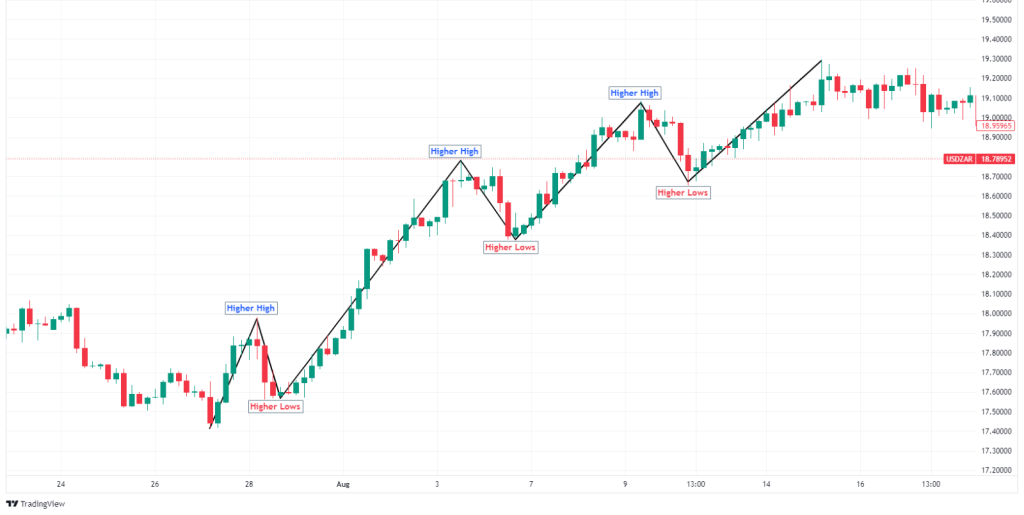
Imagine the foreign exchange market as a vast ocean, where currency pairs are like ships constantly bobbing and weaving. Every trader aboard wants to catch the correct current, the one that propels their trading vessel towards profit. But how do you discern the direction of these currents? That’s where identifying trends come in.
Trend Identification: Charting the Course
Think of a trend as the prevailing direction of a currency pair’s price movement over time. It’s like the dominant wind in the financial ocean, pushing it either upwards (uptrend), downwards (downtrend), or sideways (consolidation). Identifying these trends is crucial for making informed trading decisions.
There are two main approaches to trend detection:
- The Visual Vantage Point:
This approach involves a meticulous examination of price charts, comparable to a seasoned observer scanning the horizon. Look for patterns:
- Uptrend (Higher Highs, Higher Lows): Imagine climbing stairs – each step (higher high) is followed by a resting platform (higher low), but the overall direction is upwards.

- Downtrend (Lower Highs, Lower Lows): Think of descending stairs – each step down (lower high) is followed by a brief pause (lower low), but the overall direction is downwards.

- Flags and Pennants: These triangular formations signal a temporary pause within an ongoing trend, like a vessel adjusting its sails before continuing on its journey.
| Bearish Flag Trading Pattern | Bullish Pennant Trading Pattern |
- Technical Tools: Echolocation for Trends
Beyond visual analysis, technical indicators serve as precision instruments, scanning the market for trend signals. Some popular ones include:
- Moving Averages: These smooth out price data, revealing the underlying trend direction. A rising average suggests an uptrend, while a falling one points towards a downtrend.
- Trend Confirmation: Identify uptrends when the price stays above a rising average and downtrends when the price remains below a falling average. Look for crossovers of the price with the average for potential trend shifts.
- Support and Resistance: Moving averages can act as dynamic support and resistance levels, especially longer-term averages. Price usually bounces off these levels and can identify significant levels.
- Filtering Noise: Short-term averages smooth out price fluctuations, helping filter out market noise and focus on the underlying trend.
- Relative Strength Index (RSI): This gauge measures whether a currency is “overbought” (likely to fall) or “oversold” (likely to rise), offering clues about potential trend reversals.
- Overbought/Oversold Zones: RSI values above 70 indicate overbought conditions, potentially suggesting a sell signal. Conversely, values below 30 signal oversold conditions, potentially hinting at a buy signal.
- Divergence from Price: When the RSI diverges from the price movement, it can signal a potential trend reversal. For example, a rising price with a falling RSI suggests the uptrend might be losing momentum.
- Hidden Bullish/Bearish Divergence: Look for situations where the RSI forms higher lows during a downtrend or lower highs during an uptrend. This can signify underlying buying or selling pressure and signal a potential trend reversal.
- Average Directional Index (ADX): This indicator helps assess the strength of a trend, with higher values indicating a strong trend and lower values suggesting a weak or non-existent trend.
- Trend Strength: Higher ADX values (above 25) indicate a strong trend, suggesting higher conviction in your trading decisions. Lower values (below 20) suggest a weak trend, making it safer to wait for a more precise direction.
- Trend Direction in Range-Bound Markets: During sideways consolidation, a rising ADX can signal the potential breakout of a new trend. This can help identify entry points when the trend direction becomes clear.
- Filtering False Breakouts: A low ADX value combined with a price breakout can increase the chances of a false breakout. Waiting for higher confirmation from the ADX can reduce the risk of entering a short-lived trend.
Market Whispers: Sentiment and Trends
Trends don’t exist in isolation. They are often influenced by the collective sentiment of traders, akin to the chatter among market participants. Key sentiment drivers include:
- Economic Data: Strong economic releases can boost a currency’s value, potentially leading to an uptrend, while weak data can have the opposite effect.
- Geopolitical Events: Political turmoil or international conflicts can trigger risk aversion, impacting currencies depending on their perceived safety.
- Central Bank Policy: Interest rate decisions and monetary policy announcements can significantly influence currency pairs, potentially triggering trend changes.
Adaptation in a Dynamic Environment:
Identifying trends is an ongoing process, not a one-time revelation. The market is dynamic, and trends can shift like market sentiments. Always keep an eye on the evolving data, news, and sentiment to adapt your trading strategies accordingly.
Trading the Trend:
Once you’ve identified a trend, you can choose to “surf” it by taking positions in the direction of the prevailing current. This can be a profitable strategy, but remember, even the mightiest ocean currents can change course. Employ risk management tools like stop-loss orders to navigate potential choppy waters.
Summary:
Recognizing trends in currency pairs is a skill refined through practice and a keen understanding of market dynamics. By combining visual analysis, technical tools, and an awareness of market sentiment, traders can equip themselves to navigate the ever-changing currents of the foreign exchange market and potentially steer towards profitable trading opportunities.
Sources: TradingView, Investopedia, Insider Monkey, Finance Monthly.
Piece written by Mfanafuthi Mhlongo, Trive Financial Market Analyst
Disclaimer: Trive South Africa (Pty) Ltd (hereinafter referred to as “Trive SA”), with registration number 2005/011130/07, is an authorised Financial Services Provider in terms of the Financial Advisory and Intermediary Services Act, 37 of 2002. Trive SA is authorised and regulated by the South African Financial Sector Conduct Authority (FSCA) and holds FSP number 27231. Trive Financial Services Ltd (hereinafter referred to as “Trive MU”) holds an Investment Dealer (Full-Service Dealer, excluding Underwriting) Licence with licence number GB21026295 pursuant to section 29 of the Securities Act 2005, Rule 4 of the Securities Rules 2007, and the Financial Services Rules 2008. Trive MU is authorized and regulated by the Mauritius Financial Services Commission (FSC) and holds Global Business Licence number GB21026295 under Section 72(6) of the Financial Services Act. Trive SA and Trive MU are collectively known and referred to as “Trive Africa”.
Market and economic conditions are subject to sudden change which may have a material impact on the outcome of financial instruments and may not be suitable for all investors. Trive Africa and its employees assume no liability for any loss or damage (direct, indirect, consequential, or inconsequential) that may be suffered. Please consider the risks involved before you trade or invest. All trades on the Trive Africa platform are subject to the legal terms and conditions to which you agree to be bound. Brand Logos are owned by the respective companies and not by Trive Africa. The use of a company’s brand logo does not represent an endorsement of Trive Africa by the company, nor an endorsement of the company by Trive Africa, nor does it necessarily imply any contractual relationship. Images are for illustrative purposes only and past performance is not necessarily an indication of future performance. No services are offered to stateless persons, persons under the age of 18 years, persons and/or residents of sanctioned countries or any other jurisdiction where the distribution of leveraged instruments is prohibited, and citizens of any state or country where it may be against the law of that country to trade with a South African and/or Mauritius based company and/or where the services are not made available by Trive Africa to hold an account with us. In any case, above all, it is your responsibility to avoid contravening any legislation in the country from where you are at the time.
CFDs and other margin products are complex instruments and come with a high risk of losing money rapidly due to leverage. You should consider whether you understand how these products work and whether you can afford to take the high risk of losing your money. Professional clients can lose more than they deposit. See our full Risk Disclosure and Terms of Business for further details. Some or all of the services and products are not offered to citizens or residents of certain jurisdictions where international sanctions or local regulatory requirements restrict or prohibit them.




